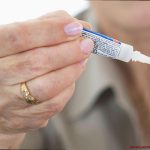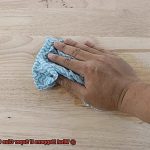Painting is an incredible way to unleash your creativity and turn plain surfaces into captivating masterpieces. Whether you’re an artist or a DIY enthusiast, finding ways to elevate your painting techniques is always exciting. One method that’s been making waves lately is adding PVA glue to paint.
PVA glue, also known as the beloved Elmer’s glue, has long been a go-to adhesive for crafts and construction projects. But what happens when we mix it with paint? Does it really make a difference in the end result? These questions have sparked curiosity and debate among artists everywhere.
In this blog post, we’ll explore the effects of adding PVA glue to paint. We’ll dive into both the scientific aspects and real-world experiences, considering how this simple addition can transform professional painting projects and enhance the work of casual DIY enthusiasts. Get ready to uncover the secrets behind this intriguing technique and gain the confidence to experiment like never before.
What is PVA Glue Used For?
Contents
- 1 What is PVA Glue Used For?
- 2 Effects of Adding PVA Glue to Paint
- 3 How Does PVA Glue Thicken Paint?
- 4 Benefits of Adding PVA Glue to Paint
- 5 Considerations When Using PVA Glue with Paint
- 6 Different Types of Paint and Their Compatibility with PVA Glue
- 7 Drying Time Considerations When Using PVA Glue with Paint
- 8 Tips for Working with PVA Glue and Paint
- 9 Conclusion
PVA glue, or polyvinyl acetate glue, is a versatile adhesive that has a wide range of uses in various applications. Its strong bonding properties and ease of use make it a popular choice among DIY enthusiasts, crafters, and professionals.
One of the primary uses of PVA glue is in woodworking projects. Whether you’re working on furniture making, cabinetry, or smaller-scale crafts, PVA glue is perfect for bonding wood pieces together. It creates a strong bond that dries clear, ensuring that the joined wood pieces remain firmly attached.
PVA glue is also extensively used in paper and cardboard crafts. It adheres paper and cardboard without warping or damaging the materials, making it ideal for scrapbooking, card making, and model building. The clear drying properties of PVA glue make it suitable for delicate papers, leaving behind no visible residue.
In fabric projects where a temporary bond is desired, PVA glue comes in handy. It is commonly used in applique work to temporarily attach fabric shapes to a base fabric before stitching them down permanently. This temporary bond allows for accurate placement and ensures that the fabric pieces stay in position during the sewing process.
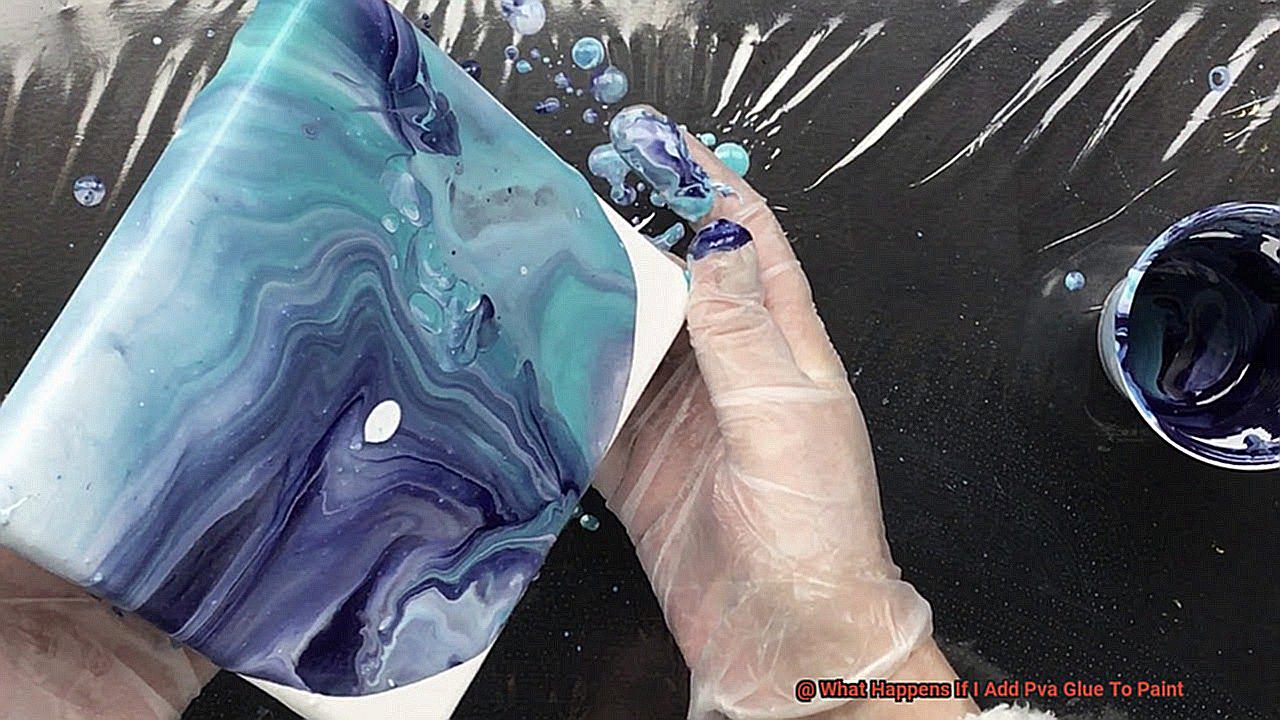
PVA glue is a staple in classrooms and is often used by students for various school projects. Its non-toxic nature and easy clean-up make it perfect for arts and crafts activities. Whether it’s creating papier-mâché sculptures or constructing models, PVA glue provides a reliable adhesive solution for young learners.
For DIY repairs around the house, PVA glue can be a lifesaver. It is commonly used to fix broken ceramics, porcelain, or glass objects. While it may not be suitable for load-bearing repairs or water exposure situations, its adhesive properties are effective in bonding these materials back together.
Bookbinding also benefits from PVA glue’s flexible yet durable bond. It secures pages to the spine and attaches covers, ensuring that the pages remain intact and the binding stays strong over time. PVA glue’s pH-neutral formulation makes it safe for use on delicate papers, preventing any damage to the pages.
Lastly, PVA glue is used in veneering projects. It provides a reliable bond between thin sheets of wood or other materials and a base surface, creating an attractive finish. The bond allows for flexibility as the wood expands and contracts with changes in humidity.
Effects of Adding PVA Glue to Paint
Adding PVA glue to paint can have a profound impact on the outcome of your artwork. The effects of this mixture can enhance your creative process and provide you with more control over your painting techniques. Whether you are a professional artist or an enthusiastic hobbyist, understanding the effects of adding PVA glue to paint can open up new possibilities for your artistic endeavors.
One of the primary effects is that it increases the viscosity of the paint, making it thicker and more manageable. This characteristic is especially advantageous when working with impasto techniques, where thick layers of paint are applied to create texture. The addition of PVA glue helps the paint hold its shape and allows for easier manipulation on the canvas.
Another effect is that it extends the drying time. PVA glue is a water-based adhesive that takes longer to dry compared to regular paint. By incorporating it into your paint mixture, you can prolong the drying process, giving you more time to work on your piece without worrying about the paint drying too quickly. This is particularly beneficial when creating blended or layered effects, as it provides greater control over the drying process.
Furthermore, adding PVA glue improves the adhesion properties of the paint mixture. PVA glue is renowned for its robust bonding capabilities, and when combined with paint, it enhances its ability to adhere to various surfaces. This advantage becomes particularly valuable when working on non-traditional painting surfaces like wood or plastic. The addition of PVA glue ensures better adhesion and prevents peeling or flaking over time.
Moreover, the addition of PVA glue can alter the finish of your artwork. Depending on the ratio of glue to paint and the type of paint used, this mixture can result in a glossy or matte finish. This flexibility allows you to customize the appearance of your artwork and achieve different visual effects. By increasing or decreasing the amount of PVA glue, you can create either a shinier finish or a more subtle and matte look.
However, it is important to be mindful of potential drawbacks when adding PVA glue to paint. One such drawback is that the added glue can affect the color of the paint. PVA glue is typically white in color, and when mixed with paint, it can lighten or alter the original hue. This may not be desirable if you aim to maintain the true colors of your paints. However, this effect can be intentionally utilized to create different shades or tints.
Additionally, using excessive amounts of PVA glue can impact the stability and longevity of your artwork. While PVA glue is a strong adhesive, over time it may become brittle or yellow, potentially compromising the integrity of your artwork. Therefore, it is crucial to use PVA glue sparingly and consider its long-term effects on your artwork’s stability and preservation.
How Does PVA Glue Thicken Paint?
PVA glue, also known as polyvinyl acetate glue, is a secret weapon in the realm of arts and crafts. But did you know that it has the power to transform your paint? By adding PVA glue to your paint, you can thicken it and unlock a world of possibilities for your artistic endeavors. So, how does this magical transformation occur?
Firstly, PVA glue creates a thicker mixture. This is especially useful when you want to apply the paint with a brush or roller without worrying about pesky drips or runs. The glue adds viscosity and gives your paint a luxurious texture that effortlessly glides onto your canvas.
Not only does PVA glue thicken your paint, but it also improves coverage. By reducing the transparency of the paint, the glue allows for better hiding power on surfaces. Say goodbye to patchy areas and hello to a vibrant and uniform finish that will dazzle viewers.
But that’s not all. When mixed with PVA glue, paint forms a stronger bond, enhancing its durability over time. No more worries about flaking or peeling – your artwork will withstand the test of time and retain its glory.
And let’s not forget about adhesion. PVA glue works its magic on porous surfaces like wood or fabric, improving the paint’s ability to stick and providing a more even and long-lasting finish. Your masterpiece will stay intact for years to come.
However, heed these cautionary words: tread lightly when using PVA glue to thicken paint. Adding too much can lead to unfortunate consequences such as cracking or an uneven finish. To achieve the best results, add small amounts gradually and test the consistency before applying it to your desired surface.
Remember to check compatibility as well. Water-based paints generally play well with PVA glue, while oil-based paints may not react favorably. Consult the manufacturer’s instructions or conduct a small test before mixing any type of paint with PVA glue.
Lastly, be patient. The thicker consistency of the paint due to the addition of PVA glue may require longer drying periods. Allow for sufficient drying time between coats or layers to ensure a flawless outcome.
Benefits of Adding PVA Glue to Paint
Let’s delve into the advantages of this combination.
- Improved Adhesive Properties: PVA glue acts as a powerful binder, enhancing the paint’s ability to adhere to various surfaces. This becomes particularly useful when working with smooth or low-porosity materials like metal or plastic, where traditional paint struggles to stick.
- Increased Durability and Flexibility: By adding PVA glue, the bond between pigment particles strengthens, resulting in a paint that resists cracking, peeling, and flaking. Furthermore, this augmentation enables the paint to withstand changes in temperature and humidity without compromising its structural integrity.
- Enhanced Coverage and Consistency: The addition of PVA glue thickens the texture of the paint, making it easier to apply while reducing the occurrence of drips or splatters. This proves invaluable when working on textured surfaces or using brushes and rollers that tend to produce uneven application.
- Faster Drying Time: PVA glue has a remarkable ability to absorb moisture from the paint, thereby accelerating the drying process. The result is a swift drying time that yields a smooth and even finish. This proves particularly advantageous for time-sensitive projects or when multiple coats of paint are required.
- Extended Shelf Life: PVA glue acts as a preservative, inhibiting the growth of mold or bacteria within the paint over time. This property helps extend the shelf life of the paint, making it ideal for individuals who frequently have leftover paint or need to store it for future use.
- Additional Protection: Incorporating PVA glue into paint creates a protective barrier that shields against moisture penetration and damage caused by UV rays or harsh weather conditions. Consequently, this prolongs the lifespan of the paint while preserving its color and vibrancy for extended periods.
It is important to note that the amount of PVA glue added to paint may vary depending on the desired effect and the type of paint being used. It is recommended to start with a small amount and gradually increase it if necessary while ensuring that the consistency and workability of the paint are not compromised.
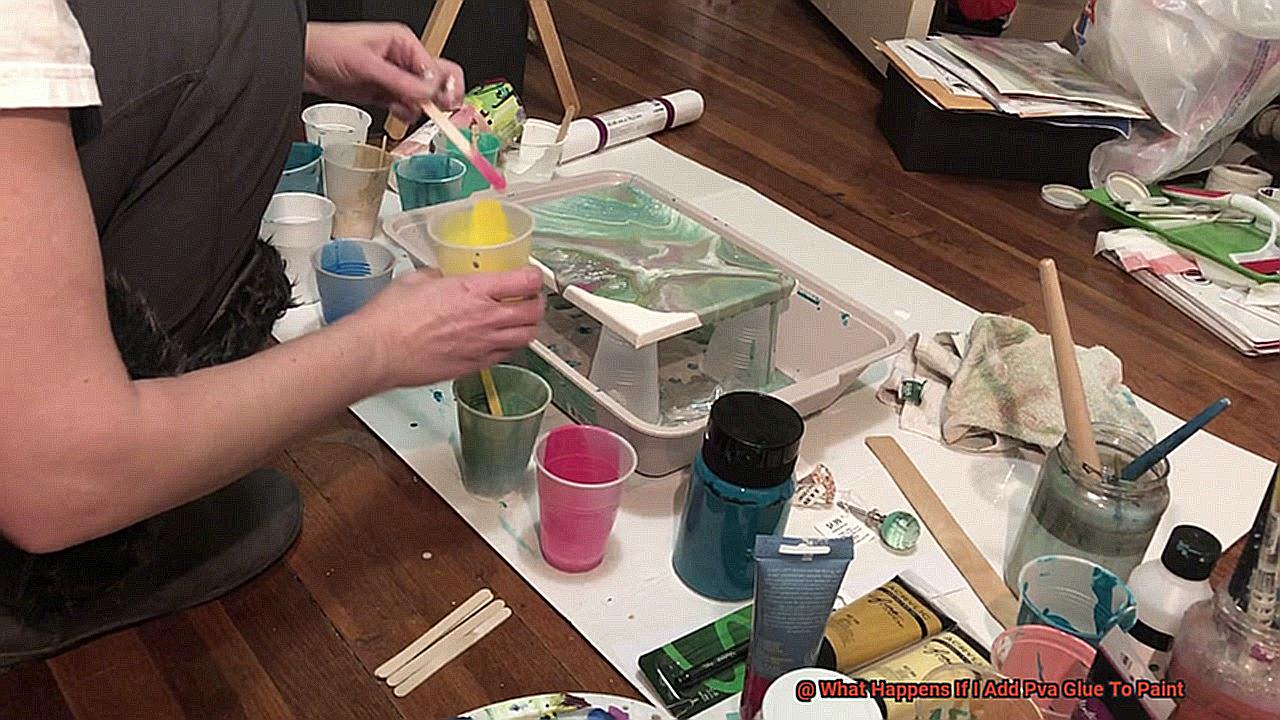
Considerations When Using PVA Glue with Paint
When it comes to using PVA glue with paint, there are several important considerations to keep in mind. These considerations will help ensure that you achieve the best results for your artwork, whether you are creating textured effects or seeking a longer working time.
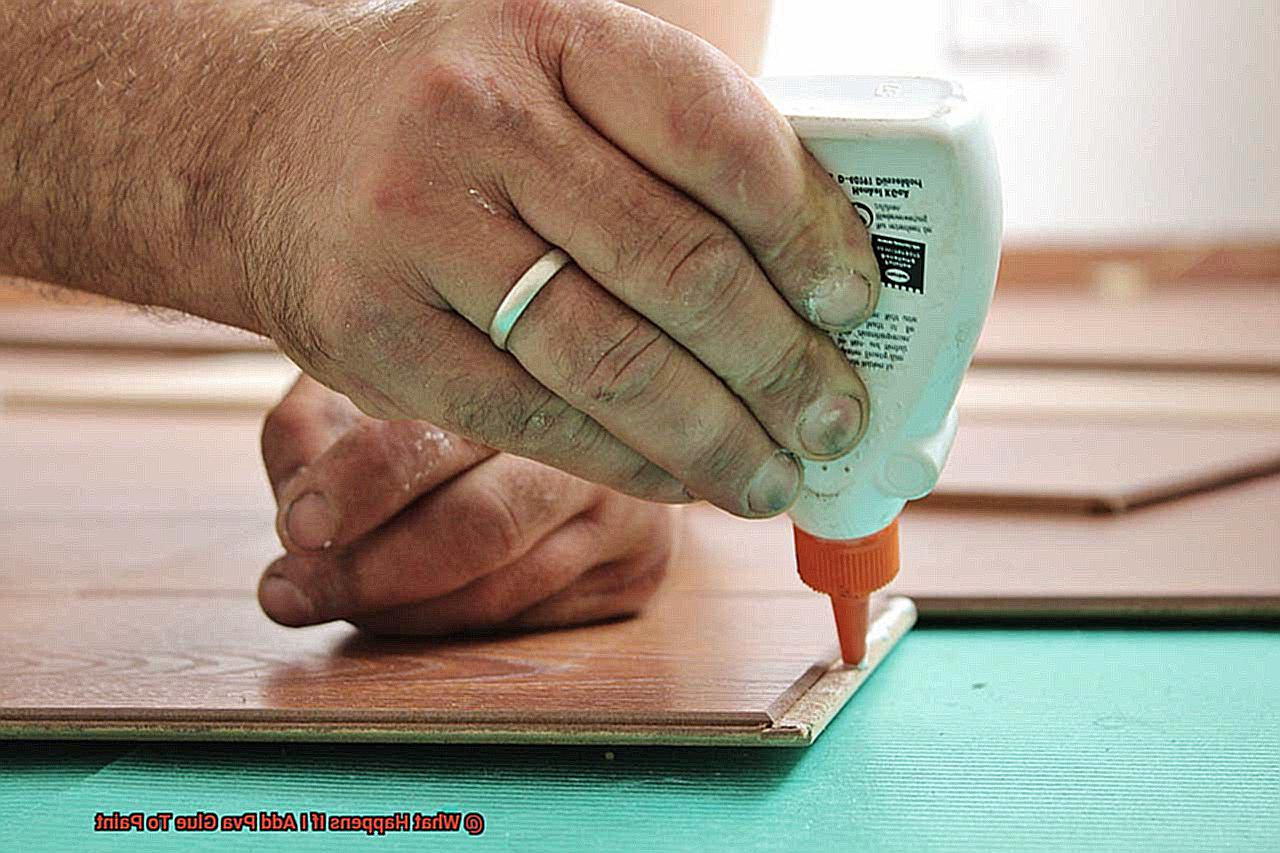
One of the first things to consider is the consistency of the mixture. PVA glue has a thick and sticky texture, which can make the paint thicker and more viscous. This can be advantageous if you want to create texture or impasto effects in your artwork. However, it can also make it more challenging to apply the paint smoothly and evenly, especially when using a brush or roller.
Another consideration is the drying time of the mixture. PVA glue extends the drying time of paint, which can be beneficial if you want more working time or easier color blending. It allows you to take your time and make adjustments as needed. However, if you have a deadline or require quick drying, this slower drying time can be frustrating.
Adding too much PVA glue can also have negative effects on your artwork. Excessive glue can cause the paint to become clumpy and difficult to work with. It may also lead to cracking or peeling once it dries. To avoid these issues, start with small amounts of PVA glue and gradually increase if necessary.
It’s also important to consider the compatibility of PVA glue with different types of paint. While PVA glue generally works well with water-based paints, it may not mix well with oil-based or specialty paints. To ensure compatibility, always test a small amount of the mixture on a separate surface before applying it to your artwork.
Lastly, when using PVA glue with paint, it’s crucial to seal and protect your finished artwork properly. PVA glue can make the paint more susceptible to moisture damage. To preserve the longevity of your piece, apply a clear varnish or sealant over the finished artwork.
Different Types of Paint and Their Compatibility with PVA Glue
Different types of paint have varying levels of compatibility with PVA glue. Acrylic paint is generally compatible with PVA glue as both are water-based. When mixed together, acrylic paint becomes more adhesive and durable, making it suitable for projects that require a stronger bond, such as painting on fabric or creating textured effects on canvas.
On the other hand, oil-based paint is not compatible with PVA glue. The differing chemical compositions of the two substances prevent them from mixing properly. If PVA glue is added to oil-based paint, it will not create a stable mixture and may cause separation or clumping. It is best to avoid mixing PVA glue with oil-based paint.
Latex paint, another type of water-based paint commonly used for interior and exterior applications, can be mixed with PVA glue. However, it is important to test the mixture on a small surface before applying it to a larger area. The addition of PVA glue may alter the consistency and drying time of latex paint, so it is important to assess the effects on a small scale first.
Watercolor paint should not be mixed with PVA glue. Watercolor paints are typically used for transparent effects on absorbent surfaces like paper. Adding PVA glue to watercolor paint can alter its transparency and flow characteristics, affecting its performance. It is best to avoid mixing PVA glue with watercolor paint.
Drying Time Considerations When Using PVA Glue with Paint
When using PVA glue with paint, it is important to consider how it will affect the drying time of the paint. PVA glue, a water-based adhesive, dries relatively quickly on its own. However, when mixed with paint, it can impact the drying process and extend the overall drying time.
The main reason PVA glue affects drying time is because it increases the thickness and viscosity of the paint mixture. This thicker consistency can impede the evaporation of water from the paint, leading to a longer drying time. The exact impact on drying time will depend on factors such as the amount of glue added and the specific type of paint used.
In general, latex-based paints tend to dry faster than oil-based paints. When PVA glue is added to latex paint, it may slightly extend the drying time but not significantly. On the other hand, when added to oil-based paints, which already have a longer drying time, PVA glue can further prolong the process.
Environmental factors such as humidity and temperature can also influence drying time when using PVA glue with paint. Higher humidity levels and lower temperatures can slow down the drying process even more. Therefore, it is advisable to take these factors into consideration when planning a project that involves using PVA glue mixed with paint.
To mitigate any potential issues with extended drying time, there are a few strategies that can be implemented. Firstly, it is recommended to use PVA glue in moderation when mixing with paint. Adding too much glue can significantly affect the consistency and drying time of the paint. Secondly, ensuring proper ventilation in the workspace can help speed up the drying process by facilitating moisture evaporation.
Additionally, if a faster drying time is desired, there are additives available on the market specifically designed to accelerate drying. These additives can be mixed with the paint and PVA glue mixture to help counteract any potential delays caused by the glue.
It is essential to allow the paint to dry thoroughly before applying additional layers or any other finishing touches. Rushing the drying process can result in uneven drying, compromised adhesion, and potential damage to the final artwork or project.
Tips for Working with PVA Glue and Paint
Mixing PVA Glue and Paint:
To achieve the best results, mix PVA glue and paint in the correct ratios. A 1:1 ratio is generally recommended, but you can adjust it based on your desired effect. Mix them in a separate container to have better control over the consistency.
Testing the Combination:
Before applying the mixture to your project, test it on a small sample or scrap material. This way, you can observe how the glue affects the paint’s consistency and color. Different paints may react differently with PVA glue, so it’s better to avoid any unpleasant surprises.
Thoroughly Stirring the Mixture:
To ensure a consistent blend, thoroughly stir the PVA glue and paint until they are well mixed. This will help distribute the glue evenly throughout the paint, preventing areas where it doesn’t adhere properly or appears streaky.
Drying Time:
Keep in mind that adding PVA glue to paint can increase drying time. The glue acts as an extender, slowing down the drying process. This can be advantageous when you need more time to work with the paint or want to achieve certain effects like blending colors.
Durability Considerations:
While PVA glue can improve adhesion, it may affect durability. The addition of glue can make the paint more flexible but less resistant to wear and tear. For projects that require high durability or heavy use, it’s best to use PVA glue mixed with paint sparingly.
Thin Layers:
When applying PVA glue mixed with paint, use thin layers instead of thick coats. Thicker layers take longer to dry and can result in cracking or peeling over time. Thin layers allow for better adhesion and a smoother finish.
Bnq00TC97tI” >
Conclusion
When you mix PVA glue with paint, something magical happens.
The glue acts as a binding agent, giving the paint a thicker and more adhesive consistency. This means that when you apply the paint to a surface, it will stick better and stay in place.
It also helps to prevent the paint from cracking or peeling over time. So if you want your paint job to have that extra durability and longevity, adding PVA glue is the way to go.
But be careful not to overdo it – adding too much glue can make the paint too thick and difficult to work with.




